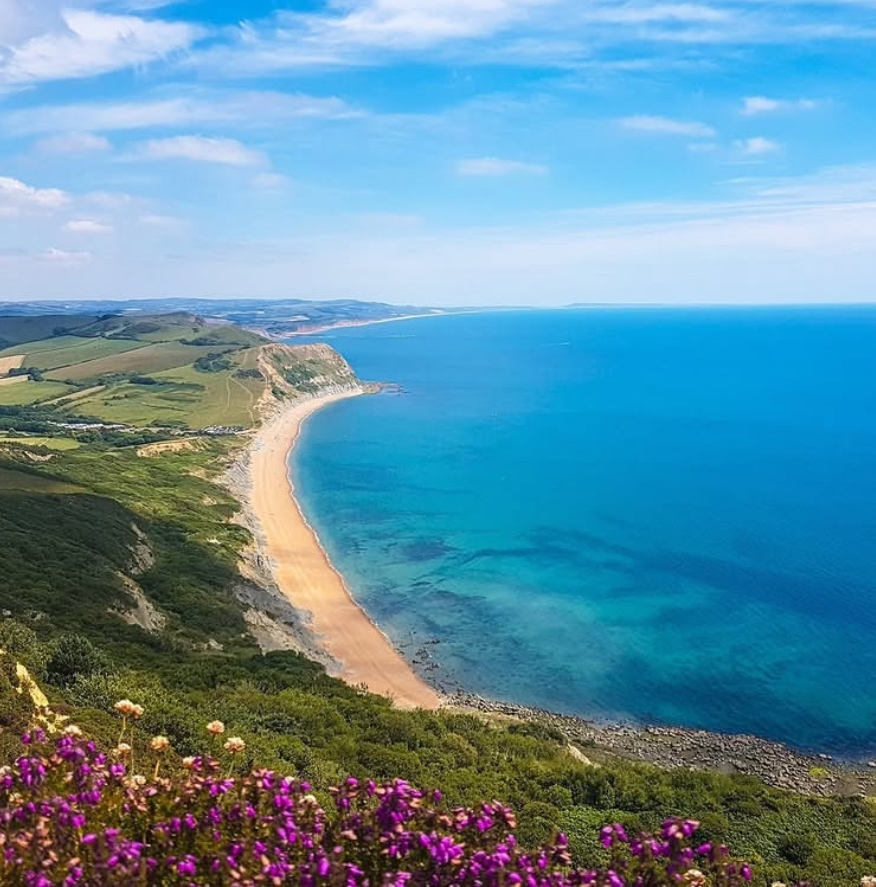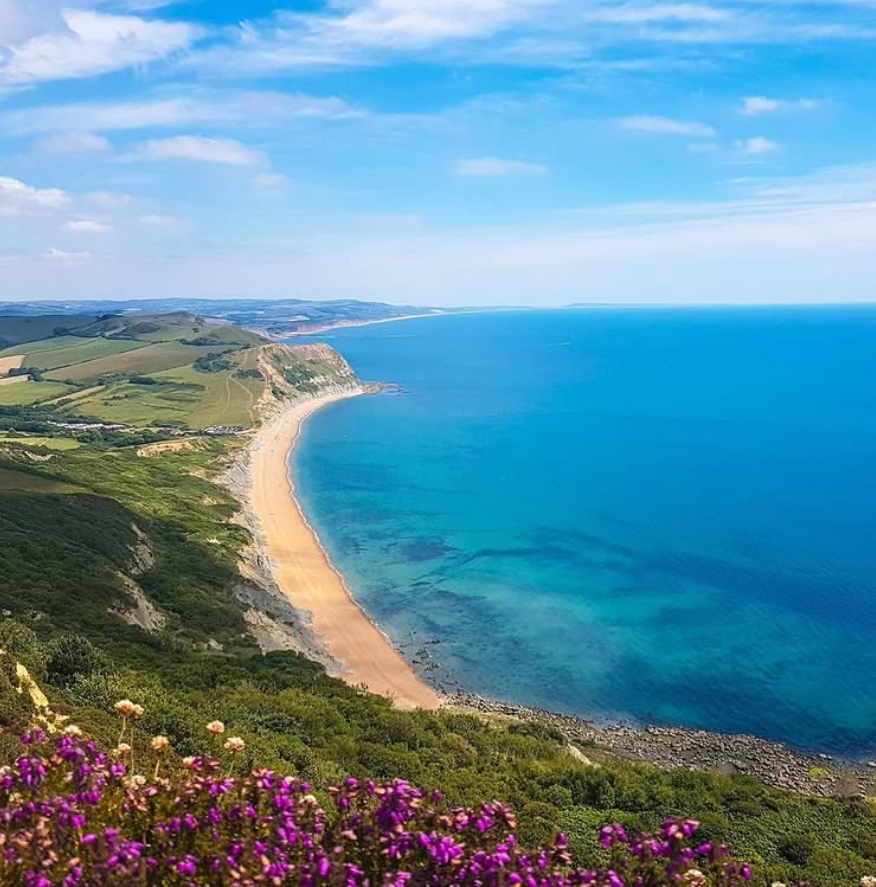@lovefordorset
Dorset’s landscape is an Area of Outstanding Natural Beauty (AONB) and the Jurassic Coast is a mesmerizing blend of geological drama, ecological diversity, and timeless beauty. Spanning coastal cliffs, rolling chalk hills, lush valleys, and expansive heathlands, it’s a region sculpted by millions of years of natural forces and human history.
Dorset’s landscape is a living canvas—raw and sculpted, ancient yet evolving. It’s less a single scene than a mosaic, where every hill, heath, and cove tells its own story.
Jurassic Coast
The 95-mile coastal stretch from Studland to Lyme Regis is a UNESCO World Heritage Site:
- Cliffs and Formations: Golden Cap (191 meters, the south coast’s highest point) towers over Lyme Bay, its golden sandstone glowing at sunset. Durdle Door, a limestone arch, and Lulworth Cove, a near-perfect horseshoe bay, are iconic, formed by relentless sea erosion.
- Chesil Beach: An 18-mile shingle barrier, this tombolo connects Portland to the mainland, its pebbles grading from pea-sized to fist-sized—a natural marvel.
- Geology: Triassic red cliffs in the west transition to Jurassic fossils at Charmouth and Cretaceous chalk stacks like Old Harry Rocks in the east, tracing three geological eras in one sweep.
Chalk Hills and Downs
- Topography: Gentle slopes and steep escarpments define the Downs, with heights like Bulbarrow Hill (274 meters) offering panoramic views over the Blackmore Vale. Purbeck Hills, more rugged, peak at Nine Barrow Down (199 meters).
- Features: Chalk grasslands bloom with orchids and butterflies, while ancient earthworks—like Maiden Castle, a sprawling Iron Age hillfort—crown the ridges.
- Chalk Figures: The Cerne Giant, a 180-foot nude figure carved into a hillside, adds enigma—possibly Iron Age or later, its origins debated.
Valleys and Rivers
- Blackmore Vale: A clay valley in northwest Dorset, it’s a patchwork of hedgerows, dairy farms, and the meandering River Stour. Known as Hardy’s “Vale of the Little Dairies,” it’s lush and pastoral.
- Marshwood Vale: Tucked in West Dorset, this secluded basin is ringed by hills, its damp meadows and woodlands hiding rare bats and newts.
- River Systems: The Stour, Frome, and Piddle wind through, feeding wetlands like those at Radipole Lake and shaping fertile floodplains.
Heathlands
- Purbeck Heaths: A 3,300-hectare expanse near Wareham blends heather, gorse, and bogs, supporting rare reptiles like sand lizards and smooth snakes. It’s a stark, open contrast to the hills.
- Studland and Godlingston: Sandy dunes and heath near Poole Harbour merge into coastal ecosystems, with views stretching to Brownsea Island.
- History: Once widespread, these Bronze Age landscapes shrank with farming—Dorset preserves some of England’s last great swathes.
Woodlands
- Powerstock Common: A West Dorset gem of oak, ash, and hazel, its tangled undergrowth shelters deer and fungi. Medieval coppicing scars linger.
- Puddletown Forest: Near Hardy’s birthplace, this conifer-heavy wood blends with heath, its edges softening into the Downs.
- Ecological Role: These pockets harbor bats, woodpeckers, and lichens, linking habitats across the AONB.
History
- Hillforts: Beyond Maiden Castle, Hambledon Hill and Hod Hill show Neolithic and Iron Age defenses, their ramparts still sharp against the skyline.
- Villages and Fields: Stone cottages in Corfe Castle or Cerne Abbas nestle into valleys, while medieval lynchets (terraced slopes) stripe the Downs.
- Coastal Towns: Lyme Regis and Weymouth hug the shore, their harbors dwarfed by cliffs.
Seasonal Features
- Spring: Wildflowers—bluebells in woods, orchids on downs—burst forth.
- Summer: Heathlands glow purple with heather; cliffs bake under sun.
- Autumn: Woodlands turn gold; mists cloak the vales.
- Winter: Bare trees reveal ancient contours; Chesil Beach roars with storms.
Views
- Walks: South West Coast Path for cliffs, Wessex Ridgeway for downs, Purbeck Way for heaths.
- Lookouts: Golden Cap, Bulbarrow Hill, or Corfe Castle’s ruins.

